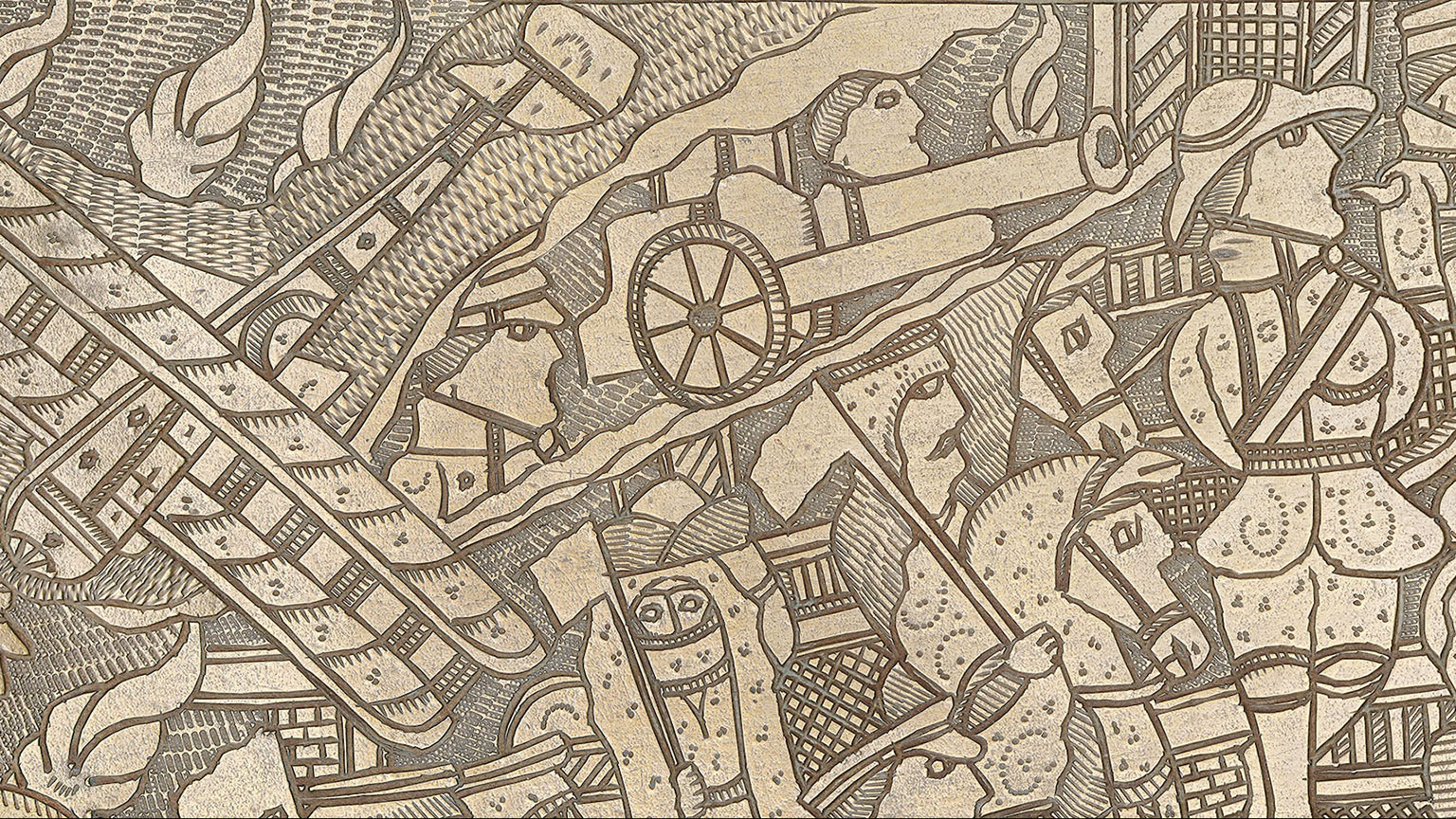Jananne Al-Ani on the hidden landscapes of objects

A new film inspired by an object in the V&A, and supported by Art Fund, is on show at Towner Eastbourne. Elizabeth Fullerton speaks to the artist and uncovers the story.
When artist Jananne Al-Ani was invited to inspect an exquisite 14th-century Islamic metalwork handbag in the Courtauld collection, which originated in her birthplace, Iraq, she was transfixed. ‘Suddenly it started to look like landscape rather than the surface of an object,’ she says. The artist was particularly fascinated by the multiple narratives such displaced objects acquire.
When Victoria and Albert Museum curator Tim Stanley showed her a 20th-century engraved brass tray in the museum collection, which ostensibly depicts an Iraqi town on Armistice Day in 1918, Al-Ani decided to make it the focus of a new work for Towner Eastbourne. Her film Timelines, co-commissioned by Film and Video Umbrella and Towner, with Art Fund support through the Moving Image Fund, is shot from an aerial perspective – something of a signature for the artist. Her films Shadow Sites I and II (2010-11), shot from above, refute the Orientalist mythology of the empty Arab desert by revealing manifold traces of human presence in the landscape.

In Timelines too, this use of a bird’s-eye approach allows fresh potential readings of the V&A tray’s imagery. Throngs of stylised British soldiers on horseback and Arab men and women are portrayed alongside donkeys, cannon and armoured vehicles on either side of the Euphrates river, which bisects the tray. A stream of Arabs crosses a bridge waving what look like surrender flags, which is curious given that the Arabs fought on the Allies’ side in the war.
‘It doesn’t add up,’ says Al-Ani. ‘I think what’s going on in this tray is that it’s not really about Armistice Day; it’s actually about the rebellion in Iraq that followed the end of the First World War.’ Having been promised independence from the Ottoman Empire in return for their support, the Arabs rose up against the British occupiers when it became clear they had no plans to leave, but were crushed by air power – hence the presence of two planes in the tray. ‘I see the tray as a slightly subversive history painting,’ Al-Ani says.
I wanted the film to feel and look like a ribbon of water to suggest the river that’s the centre of the tray... a comic strip of historic events, a scrolling endless narrative
The film’s narration is stitched from fragments of oral-history interviews the artist conducted with her mother, who is of Irish heritage. Al-Ani was struck by the parallel timeline between the Iraqi uprising and the 1919-21 Irish War of Independence against the British. At times in the narration, her mother refers to events in Ireland that could as easily have occurred in Iraq, although Al-Ani has removed references to specific places. Such mapping of connections across geographies highlights uncomfortable truths about Britain’s imperial past.


Timelines is divided into four chapters. It begins with shots of the riverscape and zooms in on two characters rowing a boat, followed by a market scene alive with bustle and optimism. Thereafter, the mood darkens, homing in on an image of an Arab man hanging. The final section opens with an aeroplane ploughing into the crowd, accompanied by sounds of strafing.
The film is presented as a long strip floating in the gallery on a giant curved screen. ‘I wanted it to feel and look like a ribbon of water to suggest the river that’s the centre of the tray, and also to reference the Assyrian friezes in the British Museum or the Bayeux Tapestry, this idea of a comic strip of historic events, a scrolling endless narrative,’ says Al-Ani. This sense is heightened through the use of computer-generated imagery, which creates the impression of travelling over a three-dimensional landscape of undulating water or hills.
Alongside Timelines, Al-Ani is curating a show of the Towner’s collection. Among the works of art she has selected are a miniature woodcut by Eric Ravilious featuring an ominous, cross-like shadow of an aeroplane on a hillside, and Jem Southam’s 1999 photograph Ditchling Beacon, Dew Pond, which will be exhibited together with the V&A’s brass tray and some of Al-Ani’s earlier works. These include the films Black Powder Peninsula (2016), which focuses on sites linked to Britain’s military, economic and industrial power, and Excavators (2010), which shows ants building a nest in a circular pile of sand.
A version of this article first appeared in the spring 2022 issue of Art Quarterly, the magazine of Art Fund.
Timelines was co-commissioned by Film and Video Umbrella and Towner Eastbourne with support from Arts Council England and from Art Fund’s Moving Image Fund, which is made possible thanks to Thomas Dane Gallery, the Sfumato Foundation and a group of private galleries and individuals.
‘Jananne Al-Ani: Timelines’ and ‘Bringing to Light: Jananne Al-Ani curates the Towner Collection’ will be on at Towner Eastbourne until 22 May. 50% off exhibitions with National Art Pass.
The more you see, the more we do.
The National Art Pass lets you enjoy free entry to hundreds of museums, galleries and historic places across the UK, while raising money to support them.